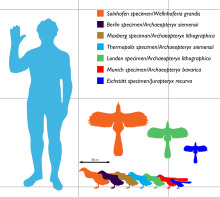Wellnhoferia
| Wellnhoferia | ||||||||||
|---|---|---|---|---|---|---|---|---|---|---|

Wellnhoferia grandis , also known as the Solnhofener Archeopteryx specimen. |
||||||||||
| Temporal occurrence | ||||||||||
| Upper Jurassic (Lower Tithonian ) | ||||||||||
| 152.1 to 147.7 million years | ||||||||||
| Locations | ||||||||||
|
||||||||||
| Systematics | ||||||||||
|
||||||||||
| Scientific name | ||||||||||
| Wellnhoferia | ||||||||||
| Elzanowski , 2001 | ||||||||||
| Art | ||||||||||
|
Wellnhoferia was a genus of primitive birds and a close relative of Archeopteryx . So far, a single skeleton is known that is traditionallyattributed to Archeopteryx and is also known as the Solnhofen Archeopteryx specimen . Whether Wellnhoferia is an independent genus or another Archeopteryx specimen is still controversial. The skeleton wasrecoveredfrom the Solnhofen limestone limestone in the Eichstätt region, one of the most important fossil deposits in the world, and is dated to the Upper Jurassic (lower Tithonian ). It is slightly larger than all Archeopteryx specimens and reached the size of a domestic chicken.
The skeleton was initially in the private fossil collection of Friedrich Müller, the former mayor of Solnhofen. Müller prepared the fossil and sold it in 1987 to the municipality of Solnhofen, where it is now exhibited in the Mayor Müller Museum . The year of discovery and the exact location are not known. Peter Wellnhofer published the first description of this fossil in 1988 .
Find
The skeleton was found within the upper Solnhofen strata, which are dated to the lower lower tithonium . It is located on a 39 × 52 cm stone slab that was put together from several fragments. Since the fossil was covered by a clayey layer, there is no counterplate, as was found in Archeopteryx specimens. The skeleton is not completely preserved; most of the skull, the rear end of the tail, parts of the spinal column and the cervical spine are missing. Only the anterior tip of the snout is preserved from the skull, while only 15 caudal vertebrae have survived. Müller artificially added the missing tail end. Evidence for feathers is only vaguely preserved - flat ripples that emanate from the left ulna (ulna) are, however, interpreted as the spring shafts of the long arm feathers. However, there are no references to tail feathers and feathers on the right wing.
The rock slab shows the right side of the fossil. The tail is pointed straight up, while the neck is very strongly curved over the back; so the skull was found in the area of the vertebrae. The rust-brown coloration of the bones is due to the diagenetic encrustation by iron-containing minerals such as limonite .
Differentiation from Archeopteryx
The genus Wellnhoferia was first described scientifically in 2001 by Andrzej Elzanowski , with the only species Wellnhoferia grandis . It differs from Archeopteryx mainly in the structure of the foot skeleton: the fourth toe has only four toe members (phalanges) - not five, as in Archeopteryx . In addition, the fourth toe is shorter overall. Elzanowski argues that the number of toe members of today's birds is not very variable, which is why it is differentiated from Archeopteryx . Ostrom (1992) noted that in today's amphibians, due to undesirable development during the embryonic phase, the limbs of the toes are sometimes reduced, which is why this feature could actually only have been a peculiarity of this individual.
While some researchers follow Elzanowski's argument and recognize Wellnhoferia as a separate genus, other researchers continue to attribute the fossil to the Archeopteryx genus . Peter Wellnhofer , who first described the fossil in 1988, still assigns it to Archeopteryx , but writes that the assignment to an independent genus "cannot be clearly invalidated".
Individual evidence
- ↑ a b c d e f Peter Wellnhofer : Archeopteryx. The primeval bird of Solnhofen. Pfeil Verlag, Munich 2008, ISBN 3-89937-076-7 .
- ^ Andrzej Elżanowski : A new genus and species for the largest specimen of Archeopteryx. In: Acta Palaeontologica Polonica. Vol. 46, No. 4, 2001, ISSN 0567-7920 , pp. 519-532, online (PDF, 4.02 MB) .
- ↑ Kevin Padian : Basal Avialae. In: David B. Weishampel , Peter Dodson , Halszka Osmólska (eds.): The Dinosauria . 2nd edition. University of California Press, Berkeley CA et al. 2004, ISBN 0-520-24209-2 , pp. 210-231, doi : 10.1525 / california / 9780520242098.003.0013 .
